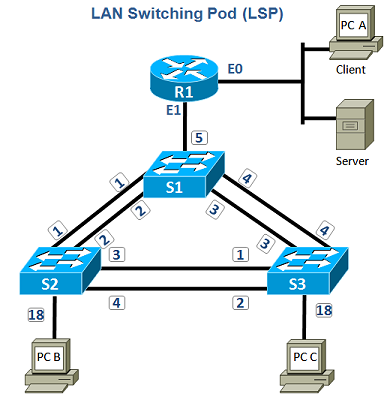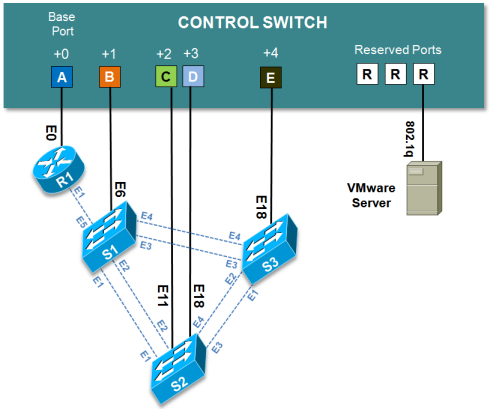This quick reference page provides a summary of the specifications of this topology. For a complete reference including installation details, please refer to the LAN Switching Pod Planning and Installation Guide
| Topology | Supports | Documentation |
|---|---|---|

|
Planning and Installation Guide |

Lab devices are part of the topology and users can interact with them either directly through the console or network.
Hardware compatibility with NETLAB+ does not guarantee the compatibility of labs. Please check the Academy curriculum, NDG pod guides, and lab support pages for specific hardware and IOS requirements.
The LAN Switching Pod includes one router (R1) and three switches (S1, S2 and S3). The following tables depict the recommended devices. The equipment listed is derived from the official Academy spreadsheet CCNAExplorationEquipmentList.xls (June 2007).
Other equipment may work if it is supported by NETLAB+ and can meet the minimum requirements for feature sets, interfaces, IOS, RAM, and Flash
All NETLAB+ topologies with lab switches and Virtual Machines require additional switch configuration tasks for successful operation. The LAN Switching Pod requires switch configuration commands on control switch ports S1, S2 and S3.
| Router / Switch |
Recommended Model(s)1 |
Ethernet Ports | Serial Ports | Recommended Serial Modules |
|---|---|---|---|---|
| R1 |
Cisco 1841 Cisco 2801 |
2 | 2 | 1 x WIC-2T |
| S1,S2,S3 |
WS-C2960-24 TTL Catalyst 2960 24 10/100 + 2 1000BT LAN Base Image |
1Other routers and switches models may be used. Please consult your Cisco NetAcad support contact for more information.
The NETLAB+ interface name translation feature is supported on this pod type. This may influence the selection of modular interface cards and slot placement within the router. Please review the expected interface names for each router.
Remote PCs are implemented by integrating with 3rd party virtualization products. The NETLAB+ documentation library includes several guides with extensive detail on the implementation of virtualization with your NETLAB+ system.
The following operating system choices are typical based on the curriculum. These choices are not mandatory; you can make substitutions provided that:
Only virtual machines are supported on this topology. Standalone PCs are not supported.
| Virtual Machine | Recommended O/S |
Functions | VLAN Offset1 |
|---|---|---|---|
| Server | CCNA Discovery Server | Server | +0 |
| Host A | Windows XP | Student PC, client activities | +0 |
| Host B | Windows XP | Student PC, client activities | +3 |
| Host C | Windows XP | Student PC, client activities | +4 |
1See the planning and installation guide for detaiils
The LSP can be used for CCNA Exploration and/or CCNA Discovery, the following table depicts which VMs should be installed for each curriculum:
| Course(s) | Server | PC A | PC B | PC C |
|---|---|---|---|---|
| CCNA Exploration | Not needed | Recommended | Recommended | Recommended |
| CCNA Discovery | Recommended | Not needed | Recommended | Recommended |
| CCNA Discovery and Exploration | Recommended | Recommended | Recommended | Recommended |
Control devices provide internal connectivity, console access, and managed power. Control devices are dynamically managed by NETLAB+ and are not accessible or configurable by end users.
| Control Device Resource | Quantity Required |
|---|---|
| Control Switch | 5 Consecutive Ports |
| Access Server | 4 Lines |
| Switched Outlet Devices | 4 Outlets |


